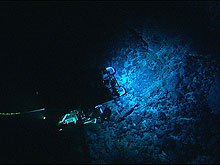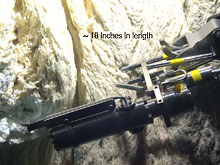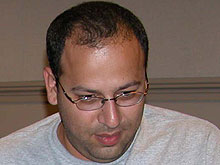
Dr. Peter Girguis, Geomicrobiologist. Image courtesy of NOAA.
Finding Needles in a Haystack
July 29, 2005
Dr. Peter Girguis
Geomicrobiologist
We have spent the last several days using some of the highest technology available to explore the seafloor. We have scientists on both the east and west coast talking to the ship and asking them to collect samples, while students and others are watching streaming live video on the internet. We are seeing things that no humans have ever seen before, and we are at the cutting edge of ocean exploration.
Once in a while, however, we have to deal with a problem that pops up. In this case, we lost a scientific water sampler that was used to collect vent fluids from the Lost City. It happened while the ROV Hercules was returning to the ship at the end of a dive. We were sitting here at the University of Washington when the pilots and scientists on board the ship (the R/V Ronald H. Brown) told us they saw the water sampler fall out of its cradle. They think it happened because part of the water sampler acted like a spring and caused it to fly out of the box. While we were sad to hear that happened, we knew that the pilots and scientists on the Ronald H. Brown did their best to prevent such things from happening.
Now I know that all of you have lost something at one point or another. I for one lose my glasses almost every time I go to sleep, and I usually fumble around for a few minutes in the dark while I try to find them with my hands. If I'm lucky, I'll have a flashlight to help me out. When we lost the bottle off the ROV Hercules, I realized that we had a challenge on our hands. Unlike my bedroom, which is only 100 square feet, the Lost City field is about 645,000 square feet (or about 60,000 square meters) and we were looking for a bottle about the size of three soda cans. This was going to take more than fumbling around, and we immediately set out to find the bottle.
The first thing we had to do is stabilize the ship and the ROVs. When we are exploring the seafloor, we have to deal with the wind blowing the ship off station, the surface currents moving the tether around, and the deep water currents moving the ROVs to and fro. That can make it really hard to stay still and look around. We asked the ship and the ROVs to get into the same position they were in when they last saw the bottle. Then, we began to search the rubble on the seafloor. We used a search pattern, called a grid, that helped us look into every nook and cranny and kept us from looking in the same place twice. Our search grid started by following a straight line and looking to our left and to your right for the bottle. We didn't find it, so we turned directly to our right and followed another straight line, again looking for the bottle. We still didn't find it, and again turned to the right and followed a straight line. This way, we could draw a map of the area we've covered and know that we haven't been spinning in circles and searching the same rubble.
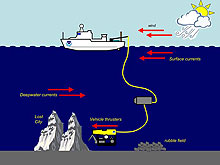
Three vehicles have to stay in alignment in order to navigate the towers of Lost City. The NOAA ship Ronald H. Brown is tethered by a cable to IFE's ROV Argus, which is tethered to IFE's ROV Hercules. Wind pushes the ship one direction, deep currents push both the Argus and the Hercules in various directions, and all three vehicles are powered to move independently. The coordination is a difficult dance of sophisticated machinery. Click image for larger view and image credit.
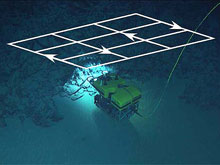
With such limited vision it is difficult to be sure that the area has been searched thoroughly. For this purpose a grid is devised and the Hercules follows this pattern to search the sea floor for the missing bottle. Various shapes and methods are used for this kind of search. In such darkness, 90 degree turns at set intervals is an approach that seems viable. Click image for larger view and image credit.
It was hard work, and we soon felt like we were trying to find a water bottle on the side of Mt. Rainer in the middle of the night using only a flashlight. We looked for several hours, and then decided to keep exploring and come back the following day to look some more. We scientists do not like to litter the seafloor, and we try to bring every thing back that we take down. That's why we'll be back in a couple of days and if we're lucky we'll get our water bottle back and continue our research on the Lost City.
Now if I can only find a way to keep from losing my glasses.
Sign up for the Ocean Explorer E-mail Update List.



























